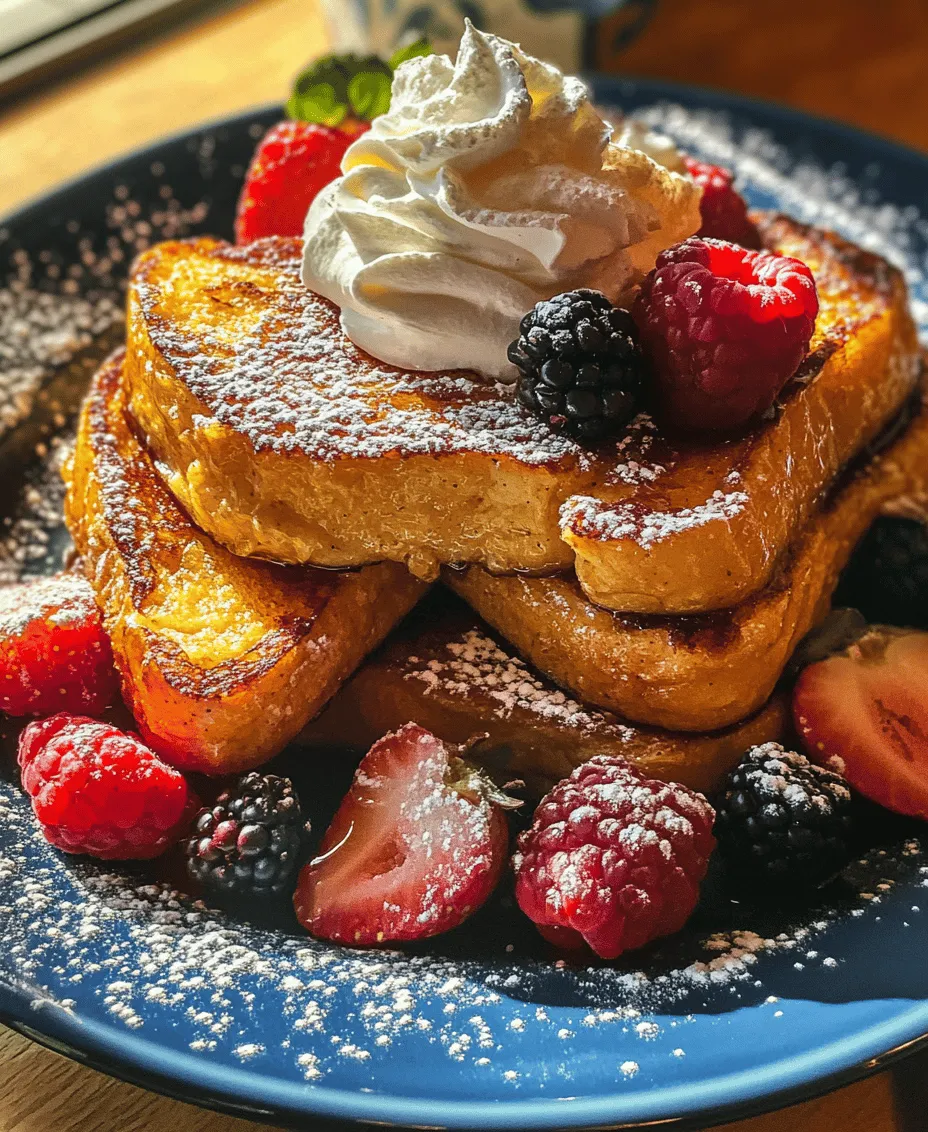Delightful mornings begin with a sumptuous breakfast that combines the elegance of crème brûlée with the comfort of French toast. The Overnight Crème Brûlée French Toast is a decadent dish that allows you to prepare a delicious breakfast ahead of time, making it the perfect choice for brunch gatherings, holiday mornings, or any day when you want to impress without the stress. This recipe marries the rich flavors of custard with the satisfying texture of golden-brown toast, creating a delightful culinary experience that will have everyone looking forward to breakfast.
This indulgent breakfast dish is not only a feast for the senses but also a testament to the beauty of preparing ahead. The concept of overnight French toast means you can spend less time in the kitchen during the morning rush and more time enjoying the company of family and friends. Imagine waking up to the warm, inviting aroma of baked French toast, with a crisp, caramelized sugar topping that crackles delightfully as you dig in.
In this article, we will guide you through the ingredients, preparation, and variations of this luxurious dish, ensuring that you can create it with ease. Let’s embark on this delightful journey to make your mornings more exquisite.
Understanding the Key Ingredients
To craft the perfect Overnight Crème Brûlée French Toast, understanding the key ingredients is essential. Each component plays a crucial role in achieving the rich flavors and delightful textures that define this dish.
Exploring Brioche and Challah Bread
The foundation of any great French toast lies in the bread. For this recipe, you’ll want to use a rich, soft bread that can absorb the custard mixture without falling apart. Brioche and challah are two popular choices, each bringing its own unique flavor and texture to the dish.
Brioche is a buttery, soft bread that is slightly sweet and has a rich flavor profile. Its tender crumb allows it to soak up the custard beautifully, creating a moist and decadent result. Brioche is often used in gourmet French toast recipes because of its ability to yield a light yet indulgent texture.
Challah, on the other hand, is a traditional Jewish bread that is also soft and slightly sweet. It has a slightly denser texture compared to brioche, which can contribute to a heartier French toast. The braided appearance of challah adds an aesthetic appeal, making it a lovely choice for special occasions.
When selecting your bread, thickness matters. Slices that are about one-inch thick are ideal, as they provide enough surface area to soak up the custard without becoming soggy. The thickness helps create a balance between the crispy exterior and soft interior that is characteristic of perfect French toast.
The Role of Eggs and Dairy
Eggs and dairy are the stars of the custard mixture, providing richness and a creamy texture that elevates the dish. The eggs contribute to the custard-like consistency that is essential for crème brûlée French toast. When baked, the eggs create a luxurious custard that envelops the bread, infusing it with flavor and moisture.
When it comes to dairy, the choice between heavy cream and milk can significantly impact the richness and flavor of your dish. Using heavy cream will yield a thicker, creamier custard that enhances the overall indulgence of the French toast. Alternatively, you can use whole milk for a lighter version; however, it may not achieve the same level of richness. A combination of both can also be used to strike a balance between creaminess and texture.
Understanding Sweeteners and Flavors
Sweeteners play a vital role in enhancing the flavor profile of your Overnight Crème Brûlée French Toast. Granulated sugar is typically used in the custard mixture to provide sweetness, while brown sugar can add a hint of caramel flavor due to its molasses content. This combination helps create a depth of flavor that complements the richness of the eggs and cream.
In addition to sugar, flavorings such as vanilla extract and ground cinnamon are crucial for infusing the dish with warmth and aromatic qualities. Vanilla extract is a staple in many custard recipes and adds a beautiful fragrance and flavor that marries well with the creaminess of the dish. Ground cinnamon, though optional, can enhance the overall taste, providing a cozy, comforting element that elevates the French toast.
Preparing the Overnight Crème Brûlée French Toast
Now that we’ve explored the key ingredients, let’s dive into the step-by-step guide to preparing this exquisite dish. The process is straightforward, making it accessible even for novice cooks.
Step-by-Step Guide to Preparing the Dish
1. Arranging the Bread for Optimal Soaking: Start by slicing your chosen bread—brioche or challah—into one-inch thick slices. Arrange the slices in a single layer in a greased baking dish, ensuring they are snug but not overcrowded. You can create a slight overlap if needed. This arrangement will allow the custard mixture to soak evenly throughout all the slices.
2. Crafting the Custard Mixture: In a large mixing bowl, whisk together your eggs, heavy cream, milk, granulated sugar, brown sugar, vanilla extract, and ground cinnamon. Be sure to whisk thoroughly until the mixture is well combined and smooth. The goal is to ensure all ingredients are evenly distributed, creating a cohesive custard base that will coat the bread slices.
3. Soaking the Bread: Once your custard mixture is ready, pour it evenly over the arranged bread slices in the baking dish. To ensure that all the bread absorbs the custard, gently press down on the bread with a spatula or your hands, ensuring each slice is saturated.
Importance of Soaking: Allow the bread to soak in the custard mixture for at least 30 minutes at room temperature. However, for the best results, cover the dish with plastic wrap and refrigerate overnight. This extended soaking time is crucial, as it allows the custard to penetrate the bread thoroughly, resulting in a rich and flavorful French toast.
Tips for Ensuring Even Saturation: If you’re short on time and can’t soak overnight, aim for a minimum of 1-2 hours in the refrigerator. You can also flip the bread slices halfway through soaking to ensure even absorption.
Baking Process and Techniques
Once you’ve allowed the bread to soak in the custard mixture, it’s time to preheat your oven and prepare for baking. The baking process is critical in achieving the desired texture and flavor.
Preheating and Preparing for Baking
1. Preheat the Oven: Preheat your oven to 350°F (175°C). Proper oven temperature is vital for achieving the right texture. A too-low temperature can lead to soggy French toast, while too high can cause the exterior to burn before the inside is fully cooked.
2. Preparing the Baking Dish: Before placing the baking dish in the oven, sprinkle a layer of granulated sugar evenly across the top of the soaked bread. This sugar will caramelize during baking, creating a delightful crust reminiscent of traditional crème brûlée.
3. Baking the French Toast: Place the baking dish in the preheated oven and bake for 35-40 minutes, or until the top is golden brown and the custard is set. To check for doneness, you can insert a knife into the center—if it comes out clean, your French toast is ready. If you prefer a slightly crispier top, you can broil it for an additional 1-2 minutes at the end of the baking time, watching closely to avoid burning.
This Overnight Crème Brûlée French Toast recipe is not only a delicious way to start your day but also an opportunity to impress your loved ones with minimal effort. As the aroma fills your kitchen, you can relish the anticipation of enjoying a dish that combines the best elements of breakfast and dessert.
Stay tuned for the next part of this article, where we will delve into serving suggestions, variations, and common questions surrounding this delightful recipe!

How to Prepare Your Baking Dish for an Even Cook
To achieve a perfectly baked Overnight Crème Brûlée French Toast, the preparation of your baking dish is crucial. Start by choosing a shallow, rectangular baking dish, ideally one that is 9×13 inches. This size provides ample space for the bread to soak in the custard mixture, ensuring each piece is coated evenly.
1. Grease the Dish: Use butter or a non-stick cooking spray to coat the bottom and sides of the baking dish. This step prevents the French toast from sticking and allows for easy removal after baking.
2. Layering the Bread: Arrange the bread slices in a single layer, overlapping them slightly. This allows the custard mixture to seep into every slice, resulting in a creamy texture. If using thicker bread slices, consider cutting them in half to facilitate even soaking.
3. Soaking Time: Allow the bread to soak in the custard mixture overnight, covered with plastic wrap. This ensures that the custard penetrates deeply into the bread, creating a rich and custardy interior when baked.
Baking to Perfection
Baking your Overnight Crème Brûlée French Toast to perfection requires attention to both visual and textural cues.
Recognizing When Your French Toast is Done: Visual and Textural Cues
As you approach the end of the baking time (typically around 45-55 minutes at 350°F), keep an eye on your French toast. Here are some signs to look for:
– Visual Cues: The top should be golden brown, and you might see a gentle bubbling around the edges of the baking dish. If the top appears too dark before the center is set, cover it loosely with aluminum foil to prevent burning.
– Textural Cues: Gently press the center of the French toast with a spatula. It should spring back slightly, indicating that the custard has set. If it feels overly jiggly, it may need more time in the oven.
Tips for Achieving a Golden Brown Top
For a beautifully golden and crisp top:
– Use a Convection Oven: If you have one, using a convection setting can help achieve an even golden brown surface due to better air circulation.
– Egg Wash: Before baking, consider brushing the top with a mixture of beaten egg and a splash of milk. This adds a lovely sheen and deepens the color as it bakes.
Brûlée Finish: Techniques for the Perfect Crust
The pièce de résistance of this dish is the brûlée finish, which gives it that signature caramelized crust. Here are two popular methods to achieve this:
Using a Kitchen Torch vs. Broiler Method: Pros and Cons
– Kitchen Torch: This method allows for precise control over the caramelization process. You can target specific areas for a deeper caramelization without affecting the rest of the dish. However, it requires a torch and a bit of practice to avoid burning.
– Broiler Method: Placing your French toast under the broiler is a quicker option that can caramelize the surface effectively. However, it’s important to watch closely, as the high heat can lead to burning if left unattended.
Ensuring a Crispy Caramelized Layer Without Burning
Regardless of the method you choose, here are some tips to ensure a successful brûlée finish:
– Sugar Selection: Use granulated sugar for the best caramelization. Sprinkle an even layer over the top; avoid excessive amounts, which can lead to uneven melting.
– Distance: If using a kitchen torch, keep it about 2-3 inches away from the surface and move it in a circular motion for even caramelization.
– Cooling Time: After applying the brûlée finish, let it cool for a minute before serving. This allows the sugar to harden and create that delightful crackly texture.
Serving Suggestions for Your Creations
Once your Overnight Crème Brûlée French Toast is baked to perfection and beautifully caramelized, it’s time to serve! Here are some suggestions to elevate your presentation and flavor profile.
Garnishing for Visual Appeal
– Fresh Berries: A mix of strawberries, blueberries, and raspberries not only adds vibrant colors to your dish but also provides a refreshing contrast to the rich flavors of the French toast. Consider arranging them artfully on one side of the plate or scattering them on top before serving.
– The Role of Whipped Cream: A dollop of freshly whipped cream can balance the sweetness of the brûlée crust. You can sweeten the cream with a touch of vanilla or flavored extract for added depth.
Pairing Suggestions
– Best Beverages to Accompany Your French Toast: A cup of freshly brewed coffee or a light tea pairs well with the richness of the French toast. If you’re in the mood for something sweeter, a glass of orange juice or a mimosa can brighten up the meal.
– Complementary Sides That Elevate the Meal: Consider serving your French toast with crispy bacon or sausage for a savory contrast. Alternatively, a side of yogurt topped with granola can add an additional layer of texture and flavor.
Variations and Customizations
One of the beauties of the Overnight Crème Brûlée French Toast is its versatility. Here are some ideas for variations and customizations to suit different tastes and dietary needs.
Exploring Flavor Variations
– Adding Different Spices: Incorporating spices like nutmeg, cardamom, or citrus zest can elevate the flavor profile. Just a pinch of nutmeg or a teaspoon of cardamom can give your French toast an aromatic twist.
– Incorporating Seasonal Fruits and Nuts: Feel free to experiment with seasonal fruits, such as peaches in summer or apples in fall. Chopped nuts like pecans or walnuts can also provide a delightful crunch when sprinkled on top just before serving.
Dietary Adjustments
– Gluten-Free Options: For those with gluten sensitivities, try using gluten-free bread alternatives. Options like gluten-free brioche or challah can work wonderfully without sacrificing flavor or texture.
– Adjusting Sweetness for Low-Sugar Diets: If you’re looking to reduce sugar, consider using a sugar substitute or reducing the amount of sugar in the custard mixture. You can also enhance sweetness with ripe fruits or a drizzle of maple syrup when serving.
Conclusion
The Overnight Crème Brûlée French Toast is not just a breakfast dish; it’s an experience that brings warmth and joy to any table. This recipe invites creativity and personalization, allowing you to adapt it to your taste preferences and dietary needs. By preparing this dish, you not only treat yourself but also create lasting memories with loved ones over a beautifully presented meal. The combination of rich flavors, textures, and visual appeal makes this French toast a standout choice for any occasion. Enjoy crafting this delightful dish and savor each bite that brings a touch of indulgence to your morning routine.



